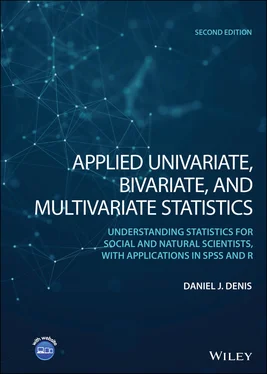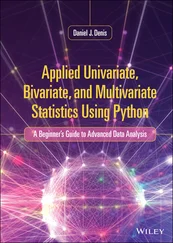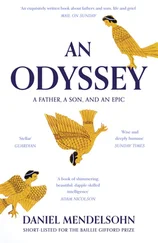2.3 SENSITIVITY AND SPECIFICITY
Sensitivity and specificity are measures historically used in diagnostic situations but can be applied to other contexts as well. We can easily adapt the data in Table 2.1to suit a brief discussion of these measures. We keep the same cell frequencies, but modify variable names so the data become a bit more applicable to a discussion of sensitivity and specificity (see Table 2.3).
The sensitivityof the diagnostic instrument is the probability that the test is positive given that the individual has the disease. In the margins, we see that 30 people have the disease, of which 20 were diagnosed with it. Thus, the sensitivity of the test is 20/30 = 0.66. The specificityof the diagnostic instrument is the probability that the test is negative, given that the individual does not have the disease. In the margins, we see that 20 people do not have the disease, of which 15 were diagnosed with not having the disease. Hence, the specificity of the test is 15/20 = 0.75. The overall prevalenceof the disease is equal to 30/50 (i.e., 30 people have the disease out of 50). One can also compute what are known as positive and negative predictive valuesfrom such tables. For these and other measures useful for diagnostic situations, see Dawson and Trapp (2004).
2.4 SCALES OF MEASUREMENT: NOMINAL, ORDINAL, INTERVAL, RATIO
Recall that in our discussion of the so‐called “soft” versus “hard” sciences in Chapter 1, we concluded that a key principal difference between the two is not necessarily one of different statistical or analytical methods used in drawing conclusions, but rather in the actual materialthat is subjected to measurement. Though this book is not about measurement per se, we nonetheless wish to review the scales of measurement as first proposed by S.S. Stevens in 1946 (Stevens, 1946).
Table 2.3 Contingency Table for 2 × 2 Diagnostic Design
|
Diagnosis Yes |
Diagnosis No |
Total |
| Disease Yes |
20 |
10 |
30 |
| Disease No |
5 |
15 |
20 |
| Total |
25 |
25 |
50 |
Before we discuss these scales, it would do well to remind ourselves just what ismeasurement in the first place. We propose the following workable definition:
Measurement is the systematic assignment of numbers to observations according to a well‐defined set of rules.
The job of the “rules” is to make good sense of the measurement process. For instance, if we simply assigned numbers to observations without a set of rules to govern the assignment, then even if I weigh more than you, I could be assigned 150 lbs and you 180 lbs. The requirement of having rules of measurement avoids such meaningless and contradictory assignments. If I weigh more than you, rules of measurement imply that my weight measurement will be larger than yours within the margin of measurement error.
Measurement at the nominalscale is hardly considered realmeasurement, because it is simply the process of grouping objects or subjects into classes. Each class is usually represented by a number, letter, name, etc. Other than naming these categories, no other properties are assumed or inferred, such as distance between objects or magnitude.
A classic example of measurement at the nominal level is that of hockey jersey numbers. That the number “99” is greater than the number “22” on the shirts of two hockey players does not imply anything about magnitude (though Wayne Gretzky did in this case wear “99” and was perhaps the best hockey player ever). The numbers 99 and 22 are simply “classes,” they are symbols used to identify (or name) one class as different or distinct from the other. The fact that we use a rational system such as the real numbers to identify these different classes of “99” versus “22” does not imply anything about order or magnitude at the level of substantive measurement. Yes, to the mathematician, 99 is indeed numerically greater than 22. That is, an order property is implied in the numbers. However, to the scientist, nothing of order or magnitude needs to be implied when working with a nominal scale.
To briefly elaborate on this point, the concept of using numbers to represent classes makes for an ideal example of the distinction between mathematical measurement versus scientific measurement. In the mathematical measurement of the distance on the real line (e.g., the “length” between two real numbers), order is a necessary implication and differentiates any two numbers on the line. In scientific measurement, though we may still use the “objects” (i.e., the numbers) of pure mathematics, whether there exist order and magnitude in our empiricalobjects of study is for us to decide as scientists with the aid of our measurement tools. It is not solely a mathematical or “abstract” consideration.
As an example, consider the following objects:
* $ # %
Though we can say, at minimum, that nominal level measurement has been achieved (the objects have different symbols, that is, different names), we cannot say anything more about either the distance or magnitude between the objects, unless we decide to impose an order relationon the above objects. For instance, if we decide, based on our rules of measurement, that $ is greater than *, then not only have we measurement at the nominal level, we also have measurement at the ordinallevel.
In addition to categorizing objects into classes, measurement at the ordinallevel imposes an order relationbetween objects. For instance, if $ is greater than * for some characteristic that these symbols represent, then we have measurement at the ordinal level. The imposition of an order relation is fundamental to any sort of true measurement. Consider that if your measurement system does not even allow you to say one thing has moreof a characteristic than another, what could be the purpose of even measuring?
Ordinal measurement, however, does not say anything about the preciseamount of magnitude between objects. For example, first place, second place, and third place in a race constitute measurement at the ordinal level, but that you finished second does not immediately tell us the distancebetween first and second, or the distancebetween second and third. To speak of distances between objects, we require measurement at the intervallevel.
Measurement at the intervallevel possesses all the features of measurement of both nominal and ordinal scales, but with the extra requirement that distances between measured objects are quantifiable, and that distances between successive measuring points on the scale are equal in magnitude. For instance, consider the measurement of temperature in degrees Fahrenheit. The change in temperature from 10 degrees to 20 degrees essentially contains the same “amount” of temperature change as that from 20 to 30 degrees. That is, the intervalsbetween measurement points are meaningful and represent an equal distance in the “thing” (i.e., temperature, in this case) we are measuring.
Is intelligence measurable on an interval scale? What would it mean for it to be measurable at the interval level? Well, supposing we base our measurements on a reputable standardized test, for IQ to be measurable at the interval scale would imply that the distancein the thing called “IQ” is equivalent from say, 90 to 100 as it is from 100 to 110. At first glance, this might appear an easy condition to satisfy, after all, the real number distance in each interval is equal to 10. However, recall that that is a distance of real numbers, not necessarily of IQ.As William James put it, we must not confuse the phenomena we study with the abstractions we use to study them. The real numbers are the abstraction. The IQ is the phenomenon. That we used a real line to measure these distances does not necessarily imply that the actual truedistances in terms of “IQ substance” corresponds one‐to‐one (or even at all) to our measurement tool. It is entirely possible that 90 to 100 represents a greater increase in IQ than does 100 to 110, making the relation between our measurement of IQ versus “true IQ,” nonlinear. Our measurement of IQ is simply not that precise to make such statements. Numerical lengthin this case may not translate to the substantive lengthof the difference under study.
Читать дальше












